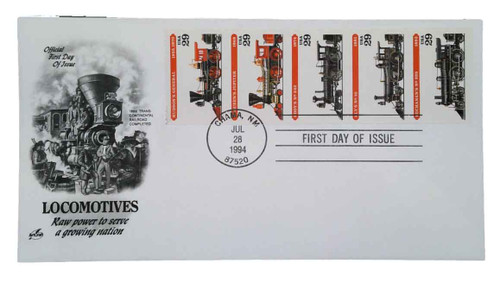
# 2844 - 1994 29c Locomotives: McQueen's Jupiter
US #2844
1994 McQueen’s Jupiter
- Part of set of five picturing American locomotives
- Similar in design to 1987 Locomotive stamps
Category of Stamp: Commemorative
Set: Locomotives
Value: 29¢, First-Class Mail rate
First Day of Issue: July 28, 1994
First Day City: Chama, New Mexico
Quantity Issued: 31,840,000
Printed by: Stamp Venturers
Printing Method/Format: Photogravure. Four panes of five stamps, from printing cylinders of 200 (10 across, 20 down)
Perforations: 11
Reason the stamp was issued: Locomotives are a popular topic with stamp collectors. These stamps appealed to them, as well as train enthusiasts.
About the stamp design: The five stamps picture locomotives produced in America in the last half of the 19th century. Each locomotive was built in a different decade. Richard Leech, who had designed the first set of Locomotive stamps (US 2363-66), worked with his son Kent on the illustrations for these stamps. Richard sketched each locomotive facing left. Kent outlined the work in pen, then Richard finished the artwork with watercolor and airbrush.
First Day City: The Locomotive stamps were dedicated in Chama, New Mexico, the site of the Cumbres and Toltec Scenic Railroad. This route runs from Cumbres Pass to Antonito, Colorado.
About the Set: This stamp is part of a set of five picturing historic locomotives built between 1850 and 1900. Each stamp shows a locomotive constructed during a different decade. Those depicted in this set are: Hudson’s General, McQueen’s Jupiter, Eddy’s No. 242, Ely’s No. 10, and Buchanan’s No. 999.
History the stamp represents:
The Civil War had just begun when Theodore Judah approached the United States government with his dream of building a railroad that would extend from coast to coast. Eager to link the Western states to the Union, Congress agreed to his plan and in 1862 passed the Pacific Railroad Act, authorizing the building of a transcontinental railroad. Two companies were chosen to do the job.
In 1863 the Union Pacific Railroad began laying tracks westward from Omaha, Nebraska, while the Central Pacific laid tracks eastward from Sacramento, California. On May 10, 1869, the two railroads met at Promontory, Utah, becoming the world’s first transcontinental railroad. In a jubilant celebration, officials from both railroads drove ceremonial golden spikes to hold down the last rail - the 2,000-mile-long line spanning the West had at long last been completed.
Designed by Walter McQueen, the Jupiter found its way into history books quite by accident. Operating for a mere six weeks, it was called into service when the locomotive scheduled to be on hand for the driving of the golden spike struck a log lying next to the track and was disabled. Pressed into action, the Jupiter arrived at Promontory on May 7th and was part of the history-making celebration a few days later.
US #2844
1994 McQueen’s Jupiter
- Part of set of five picturing American locomotives
- Similar in design to 1987 Locomotive stamps
Category of Stamp: Commemorative
Set: Locomotives
Value: 29¢, First-Class Mail rate
First Day of Issue: July 28, 1994
First Day City: Chama, New Mexico
Quantity Issued: 31,840,000
Printed by: Stamp Venturers
Printing Method/Format: Photogravure. Four panes of five stamps, from printing cylinders of 200 (10 across, 20 down)
Perforations: 11
Reason the stamp was issued: Locomotives are a popular topic with stamp collectors. These stamps appealed to them, as well as train enthusiasts.
About the stamp design: The five stamps picture locomotives produced in America in the last half of the 19th century. Each locomotive was built in a different decade. Richard Leech, who had designed the first set of Locomotive stamps (US 2363-66), worked with his son Kent on the illustrations for these stamps. Richard sketched each locomotive facing left. Kent outlined the work in pen, then Richard finished the artwork with watercolor and airbrush.
First Day City: The Locomotive stamps were dedicated in Chama, New Mexico, the site of the Cumbres and Toltec Scenic Railroad. This route runs from Cumbres Pass to Antonito, Colorado.
About the Set: This stamp is part of a set of five picturing historic locomotives built between 1850 and 1900. Each stamp shows a locomotive constructed during a different decade. Those depicted in this set are: Hudson’s General, McQueen’s Jupiter, Eddy’s No. 242, Ely’s No. 10, and Buchanan’s No. 999.
History the stamp represents:
The Civil War had just begun when Theodore Judah approached the United States government with his dream of building a railroad that would extend from coast to coast. Eager to link the Western states to the Union, Congress agreed to his plan and in 1862 passed the Pacific Railroad Act, authorizing the building of a transcontinental railroad. Two companies were chosen to do the job.
In 1863 the Union Pacific Railroad began laying tracks westward from Omaha, Nebraska, while the Central Pacific laid tracks eastward from Sacramento, California. On May 10, 1869, the two railroads met at Promontory, Utah, becoming the world’s first transcontinental railroad. In a jubilant celebration, officials from both railroads drove ceremonial golden spikes to hold down the last rail - the 2,000-mile-long line spanning the West had at long last been completed.
Designed by Walter McQueen, the Jupiter found its way into history books quite by accident. Operating for a mere six weeks, it was called into service when the locomotive scheduled to be on hand for the driving of the golden spike struck a log lying next to the track and was disabled. Pressed into action, the Jupiter arrived at Promontory on May 7th and was part of the history-making celebration a few days later.











